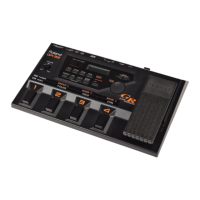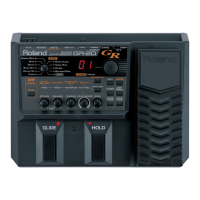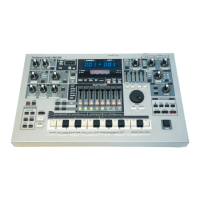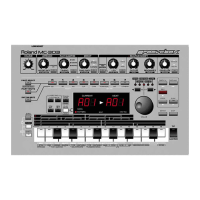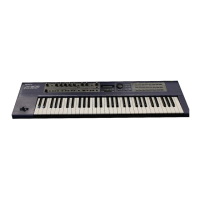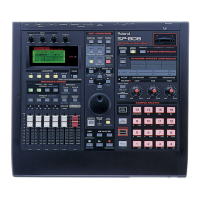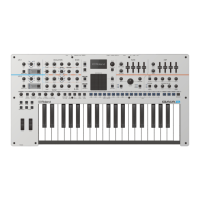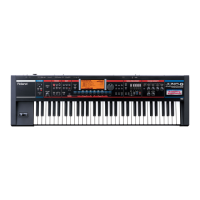Playing the Internal Synth Sounds with the Guitar
16
After checking the connections to whatever amplifier
you are using, and completing the sensitivity settings
and tuning the guitar, try playing some sounds.
<How to Play the GR-30’s Sounds with the Guitar>
1. Make sure that A11 is displayed. (p. 13)
2. Set the GK-2A’s selector switch to SYNTH.
3. Turn SYNTH VOL on the GK-2A counterclockwise
to raise the volume to a suitable level.
4. Set the VOLUME on the GR-30 to the center mark-
ing.
5. When you press pedal 3, the number in the display
changes to “A13”, and the patch (tone) is switched.
With these steps completed, you are now ready to
play. Play your guitar while gradually turning up the
volume on your amplifier, and you will hear the set
tone, patch A13, from the GR-30’s internal sound gen-
erator.
❍ To Hear the Normal Guitar Sound...
Set the GK-2A’s selector switch to MIX. If you then
switch to GUITAR, the synthesizer sound generator
will be muted, and only the sound of the guitar will
remain.
❍ To Change the Volume of the Synth sound genera-
tor...
Adjust the volume with either the SYNTH VOL knob
on the GK-2A, or the GR-30’s VOLUME knob.
➼
Using the GR-30’s VOLUME knob changes the total
volume from the MIX OUT jacks. Thus, when the gui-
tar sound is output from MIX OUT, both guitar and
synthesizer sound levels are changed.
(The guitar sound output of the GUITAR OUT jack is
not affected. Guitar volume also unchanged when you
use the GK-2A’s SYNTH VOL knob.)
● Since the GR-30’s sound generator is
designed to achieve a wide range of
tone changes, depending on the setting,
sound levels may change greatly.
Particularly when using the wah effect,
or when adjusting certain tones, in
order to prevent damage to your hear-
ing, amps, speakers, and the like due to
large or sudden changes in output, be
careful not to set volume levels too
high.
What to do if there is No Sound When the Guitar is Played
First check the following:
• Check to see that amplifier and other equipment
volume levels are correct, and confirm that all the
equipment is properly connected. (p. 11)
• Make sure the volume on both the GR-30 and the
GK-2A are up. Also make sure that the
guitar/synth switch is not set to GUITAR.
●●●●●●●●●●●●●●●●●●●●●●●●●●●●●●●●●●●●●●●●●●●●●●●●●●●●●●●●●●●●●●●●●●●●●●●●●●●●●●●●●●●●●●●●●●●●●●●●●●●●
When the Sound of a Specified Patch (Tones:
p. 29) Fails to Play on All the Strings (or on a
Particular String)
• If an expression pedal (p. 49) is connected, try press-
ing the pedal as far down as it will go.
• When using a monaural connection with your amp,
be sure to turn the power on while pedal 1 is
pressed.
• Confirm that the synth sounds for all of the strings
have not been muted due to being switched to
LAYER (p. 34).
• Even if the Arpeggiator is on, check to see if there is
indeed any data in the arpeggio pattern (p. 55—63).
●●●●●●●●●●●●●●●●●●●●●●●●●●●●●●●●●●●●●●●●●●●●●●●●●●●●●●●●●●●●●●●●●●●●●●●●●●●●●●●●●●●●●●●●●●●●●●●●●●●●
✽
If the volume levels of the strings vary widely, please
recheck the PICKUP SENS settings. (p. 14)

